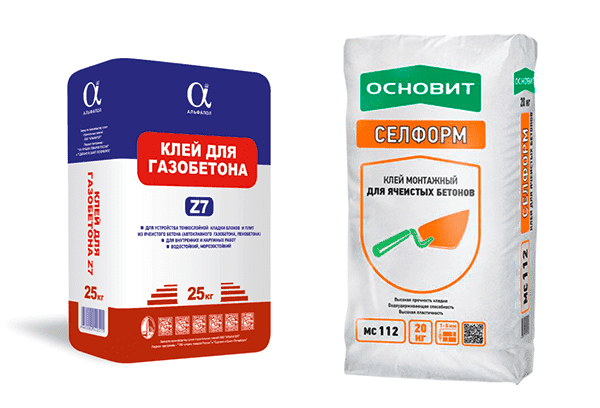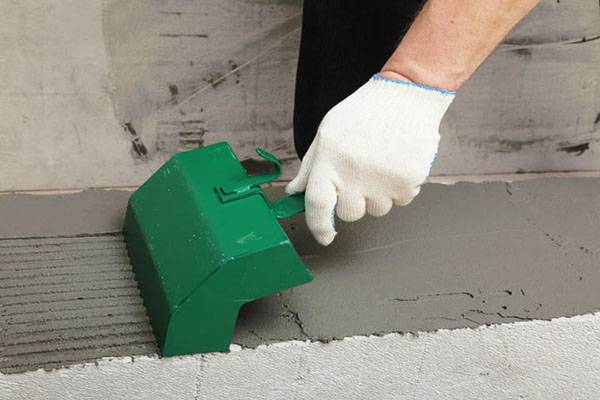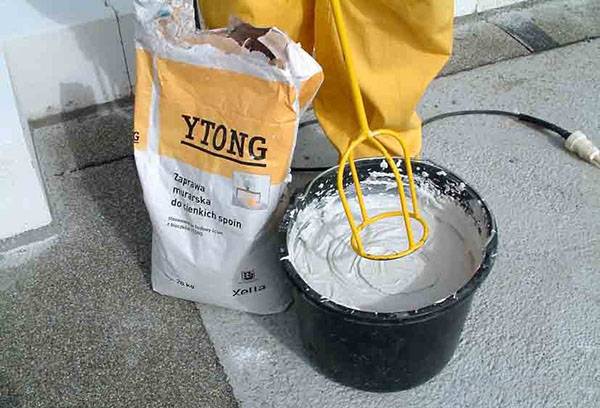Features of working with aerated concrete adhesive
Often during construction it becomes necessary to choose a good adhesive for aerated concrete. There are different brands of this material - if you use the composition with the necessary additives, you can carry out work even in winter, the quality of the masonry will not be affected. The blocks can also be laid on ordinary cement mortar, but its thermal conductivity is higher than that of cellular blocks, and therefore heat will escape from the house to the street through thick seams. Try new materials in your work, they are simple and convenient.

Composition of aerated concrete adhesive, pros and cons of the material
The glue is based on high-quality Portland cement. In combination with sand, this material is used to prepare mortars, and with the introduction of additional components, new mixtures are obtained for connecting bricks and blocks.
In addition to cement, the following components are added to the dry composition:
- natural mineral fillers, most often fine sand;
- polymer components, such as polyurethane powder for plasticity;
- antifreeze additives for winter mixture.
There are 2 types of glue available. The white mixture is suitable for work in the warm season or in winter in a heated room. When hardened, the seams acquire the color and texture of the blocks and become invisible. The wall turns out homogeneous; it does not need to be finished. Gray adhesive for aerated concrete blocks is suitable for use in any season, as long as the temperature does not drop below -10⁰C.
Advice
If you carry out work at sub-zero temperatures, make sure that the solution does not cool below 0⁰C.
The developers have created a mixture with physical properties that are as close as possible to the characteristics of aerated concrete - after hardening, the result is the same foam that is used in the manufacture of porous masonry stone. A structure made from such a set of materials can be considered monolithic; with temperature changes, compression and expansion occur evenly over the entire area, the seams do not crack. Glue for aerated concrete blocks, even with a thickness of 1 mm, reliably holds the structure together.
Other advantages of glue:
- ease of preparation of the working solution;
- strong bonding of blocks;
- plastic;
- no shrinkage when drying;
- fast setting;
- ease of application.
When laying aerated concrete with glue, the thickness of the seam is from 2 to 4 mm, the blocks fit tightly to each other. As a result, the material is consumed economically; there is no need to bring many bags of dry mixture to the construction site. After the solution hardens, a durable, waterproof, frost-resistant structure is obtained.
The disadvantages of the material include the fact that only even blocks with a flat surface of all edges can be used for masonry. Chips, potholes, and cracks are not allowed. If you purchased cheap substandard aerated concrete with deviations from the geometric shape, you will not get a durable structure. Another disadvantage is the short “lifetime” of the prepared solution. If a person does not have sufficient experience and works slowly, and it is winter outside, he will have to stop every half hour and prepare a new portion of the working staff.
How to lay a gas block on glue?
Before starting laying, you need to prepare a working solution. Measure the temperature of the water with which you will pour the dry mixture; it should be from 15 to 18⁰C.If you take water from a spring or well at your dacha, it may be too cold. Place the bucket in the sun to warm the liquid. High-quality glue for aerated concrete blocks will only work if you follow all the rules for its preparation.
From equipment and tools for work you will need:
- measuring utensils and scales;
- mixing container;
- electric drill and “construction mixer” attachment;
- ladle for applying adhesive composition;
- notched metal spatula;
- rubber mallet for adjusting the installed block;
- saw with teeth made of hard alloys;
- wall chaser;
- graters for cleaning surfaces.
Important!
Do not measure the components “by eye”; you may make a mistake, and if the ratio is incorrect, the seam will not be strong enough.
Pour the dry mixture into a tank of sufficient volume, add water in the required proportion and mix the solution with an electric drill. It is better not to try to mix the composition by hand, it will take a lot of time, and the glue may be mixed unevenly, with lumps. Let the solution sit for 10 minutes and knead a second time. To prepare a solution for work in the cold season, mix aerated concrete adhesive in water at a temperature of +60⁰C. Do not apply a large amount; in winter, the prepared mixture must be used within half an hour, otherwise it will lose its quality.
Before applying glue, the surface must be cleaned of dust, dirt, grease stains, and wet areas must be dried. Lightly moisten the areas where the glue is applied with water. Apply the glue in a thin layer using a notched trowel. Coat all horizontal and vertical surfaces that the gas block will come into contact with and install it in the desired position.If you accidentally install the unit unevenly, its position can be corrected within 10 minutes. After work, cover the structure with a tarp so that the solution does not dry out too quickly.
Advice
When working, keep measuring instruments at hand: level, rod, plumb line. From time to time, check whether the structure is even and there are no deviations from the plane.
To work at above-zero temperatures, you can take a special adhesive for aerated concrete “KREPS”. It contains a very fine filler, so the seam is no more than 3 mm thick. A bag weighing 25 kg is enough for 1 m3 masonry, the lifetime of the working solution is 4 hours. The glue sets in 10 minutes, during which time you can correct a poorly laid block.
Glue consumption calculator - independent calculation
The consumption of the solution and the proportions of water and dry mixture are indicated on the packaging or in the instructions for the glue. Typically, for 1 kg of dry mixture you need to take from 200 to 220 ml of water. A bag will require 5 to 5.5 liters. Do not ignore the manufacturer's recommendations, because technologies and adhesive compositions are constantly being improved, and a new material may require a different ratio of liquid to dry matter.
The consumption of the working solution is affected by:
- qualifications and experience of the builder;
- seam thickness;
- quality of instruments;
- surface condition;
- weather.
For an approximate calculation of the required quantity, it is recommended to take 1 bag (25 kg) for 1 m3 masonry with a seam thickness of 3 mm. Experienced craftsmen themselves know how much material they will need for their work, and adjust the recommended amount up or down. If this is your first time working with aerated concrete, it is better to purchase at least 1.5 bags per 1 m3. Most likely, on your first attempt you will not be able to apply the composition in a thin enough layer and the material consumption will increase.
Important!
Don’t forget to purchase regular cement for preparing masonry mortar. When starting work, the first row of blocks must be laid on the composition that is used for brick walls, and only the next stones should be placed on glue.
For those new to construction, it is better to work in the summer. Be sure to read all recommendations on the mixture packaging or instructions. On the first day, it is advisable to carry out the laying under the guidance of an experienced craftsman. He will check how correctly you mixed the solution and will point out errors in applying the composition to the surface. When you understand the basic rules, things will go faster and material consumption will decrease. In a few days you will master convenient working techniques: aerated concrete adhesive is created with convenience and simplicity in mind. Do not forget that the white composition is only suitable in the summer; in cold weather you need to use special winter brands.
Aerated concrete is an excellent building material; with its light weight, it serves as a good heat insulator. All the advantages of aerated blocks can only appear when they are laid on the correct adhesive. Take the time to read the information on the packaging of several brands of glue, compare their qualities, and choose which one is best suited for your conditions. Do not hesitate to ask for advice from the manager of a trading company or a professional builder; they will explain which mixture is intended for which work. You can live in a room with poor finishing for a while and then make cosmetic repairs, but the load-bearing structures must be immediately installed reliably and firmly.Take on the task with full responsibility, and if you are not confident in your abilities, entrust the work to a team of craftsmen.

